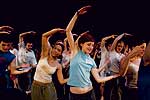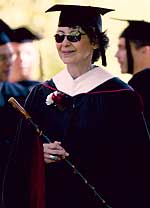Quad Angles
Dance of a Lifetime
Edited by H. Jay Burns and Doug Hubley
To the sound of folksy guitar, recumbent women rolled out onto the bare Schaeffer Theatre stage. Then someone shouted.

Modern Dance Company alumni rehearse for the 35th anniversary concert honoring Marcy Plavin.
The music stopped. Bodies stalled. A head — second roller in — popped up: Dervilla McCann ’77. “Wrong song!” she called into the auditorium’s twilight. And the rollers rolled back offstage.
Four hours ’til show time. This was the only chance to rehearse onstage. Modern Dance Company alumni concerts are always spirited, but this one, Once More with Feeling on May 1, was electric. It was the company’s 35th anniversary, and something bigger besides.
“House rules: We’re here to celebrate Marcy Plavin,” choreographer Michael Foley ’89 had earlier told 125 alums in the hall, of whom 100 would dance that evening. Hooting and clapping, they rose to their feet.

Marcy Plavin at Commencement 2004.
Plavin laughed modestly, but recovered quickly. “Women, please wear makeup and don’t wear watches and jewelry,” instructed the MDC founder and Bates’ longtime director of dance. (“How many times have we heard that?” someone teased.)
Then Plavin got to the hardest part — the subject of her retirement — by introducing her successor, Carol Dilley. “You’re this incredible legacy I want to get to know!” Dilley told the dancers.
That took pluck in front of this intimidatingly loyal crowd. “Marcy is my connection to Bates,” said Joan Buerk ’85, who had come from London. “Dance is the basis of all my friendships here.” Up from Cambridge, Mass., Kate Nies ’02 called Marcy “everybody’s mom. I can talk to her about anything.” John McCadden ’74 traveled from San Francisco just to watch. “In dance I found community,” he said. “That’s what Marcy creates — relationships with her, relationships with other dancers, and a very deep, powerful relationship with dance. It enters your bones and never leaves.”
Come evening, the house filled quickly. The opener, Plavin’s 1973 Freedom, tugged at hearts — many spectators had danced it. The piece is tautly constructed yet uplifting, a metaphor for structure as launch pad. From it this night leapt jugglers and hippies, moms and babies, even frolicsome men in underwear.
Liliana Amador-Marty ’91 and Alison Oakes ’92 slid, crept, and intertwined in their haunting Crawlspace. Theater-circus performers Andrew Adams ’99 and Erika Gilfether exhibited jaw-dropping strength and grace on high in Binded Freedom. The current company danced Alwin Nikolais’s Tensile Involvement with intense precision, in a web of giant elastic bands.
After intermission, Foley sauntered onstage. “Let me tell you about Marcy,” he began. Lynda Plavin Fitzgerald ’79, Marcy’s daughter, started talking right over him: “When I was little . . .” Dancers filled the stage and aisles, creating a din of Marcy stories that morphed into clapping, stomping, finger-snapping — different beats for different classes that melded, somehow, into consonance.
Group performances created just that afternoon unfolded in rapid succession, some elegant, others silly, like those bodies rolling to — yes — James Taylor’s “Steamroller.” The finale, by choreographer John Carrafa ’76, AWOL from Urinetown in Toronto, echoed Foley’s theme of individual and unified expression. Each group swept out across the stage, then all snaked back, hand in hand, in tribute.
“It was,” Plavin would say later, “the most extraordinary thing.”
McCann agreed. “It could have been mournful time, about never again. But it felt like beginning.”